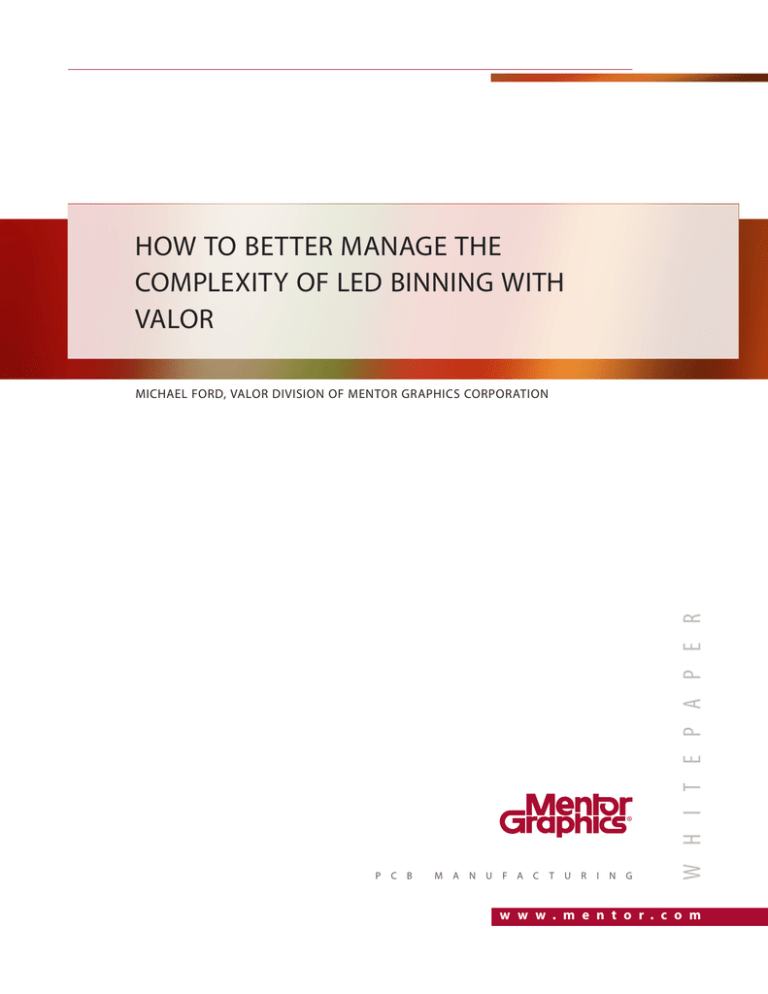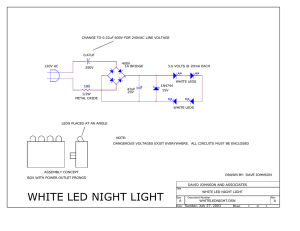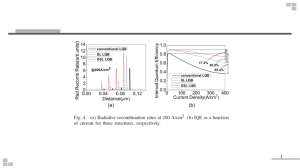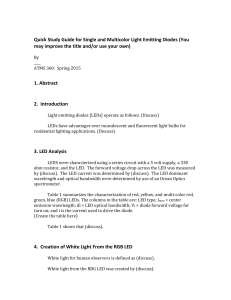
HOW TO BETTER MANAGE THE
COMPLEXITY OF LED BINNING WITH
VALOR
P
C B
M
A
N
U
F A C
T
U
R
I
N
G
W H I T E P A P E R
MICHAEL FORD, VALOR DIVISION OF MENTOR GRAPHICS CORPORATION
w w w . m e n t o r . c o m
How to Better Manage the Complexity of LED Binning with Valor
INTRODUCTION
When using surface-mount technology (SMT) to manufacture electronic panels that consist of discrete
light-emitting diode (LED) arrays, it’s difficult to ensure uniform brightness and color across the panel
because of variance in the manufacturing process of discrete LEDs and the way in which they are
purchased. The process to achieve this is complex because changes are required to the bill of materials
(BOM) during production execution to compensate for individual LED characteristics. Mistakes are easy to
make and can result in significant and difficult re-work, or, if not noticed, quality issues in the final
product. However, the Valor® MSS software solutions can help to solve this problem by automating and
optimizing the materials operation, ensuring correct material selection and supply to the SMD machine,
as well as verification of materials setup that includes taking account of the variances of LEDs and
associated circuitry.
THE CHALLENGES OF USING LED ARRAYS IN PCB
MANUFACTURING
The advantages of LEDs over standard light sources, include lower power consumption, smaller size,
longer life, and greater robustness encourage manufacturers to incorporate them into a growing number
of electronic products. With their greater adoption across many different applications, prices of LEDs are
decreasing even while their brightness and efficiency is increasing. 2D arrays of individual discrete LEDs
were introduced to provide informational displays that show dynamic and scrolling information, for
example in train stations, airports, etc. Subsequently, applications for LED arrays have expanded and now
include automotive lamps and general purpose lighting, as well as more advanced warning signs, vision
systems, and other lighting applications.
As a result of the variable nature of the manufacturing process of discrete LEDs, they can have a
significant range of brightness levels and color temperatures when used under the same operating
conditions. This variation may not be significant for many applications that use discrete LEDs individually,
but where many LEDs are mounted together in close proximity in an array, the effect of the differences
can become noticeable.
To reduce the effect of this variation, within each manufacturing part number (MPN) for such LEDs,
manufacturers provide a range of classifications in which to group LEDs with closely matched
characteristics. These are called “brightness index number” (BIN) or “light classes.” LEDs are filtered into
their appropriate BINs before being packaged onto reels. Each reel shipped will then contain LEDs of the
same BIN and will be labeled with the manufacturer part number and the BIN code, either as separate
information or as an extension to the MPN, or sometimes the batch number, depending on the
manufacturer.
In the purchasing cycle, discrete LEDs are supplied to electronic product manufacturers based only on
the MPN. Orders of LEDs supplied under a single MPN are likely to be composed of reels of different BINs.
For the creation of LED array products, compensation must be made when using the LEDs from different
BINs so that the brightness and color characteristics of each LED in the array will have the same
brightness across the whole area of the panel.
An easy solution to this problem would be to always ensure that LEDs with the same BIN are used
throughout a work-order of LED array products. However, this is not practically because usually the stock
of LEDs of any single BIN will not be enough to satisfy the complete work-order.
w w w. m e nto r. co m / v a l o r
2
How to Better Manage the Complexity of LED Binning with Valor
To make up for these differences, an electrical adjustment is used so that LEDs with different BIN
numbers can be used together across different PCBs within the same work-order. This is achieved by
effecting changes in the LED driver circuitry (normally resistors) to vary the current applied to each LED
depending on which BIN is being used. These are referred to as the dependent materials. For example, in
a particular constant current source used to drive an LED of BIN “A,” a 120 ohm resistor could be used.
Where the BIN of the LED changes to “B,” which is an LED with slightly less brightness that BIN “A,” the
120 ohm resistor should be changed to a 100 ohm to make the “B” LED have the same brightness as that
from BIN “A.” The result is that as the LED BIN changes, so does the part number of the dependent
resistor. Because the BIN of the LED may change during the execution of the work-order, a dynamically
changing BOM has to be managed.
Traditional methods for managing material setup validation and traceability where the BOM is normally
set up at the beginning of the work-order and not subsequently changed are insufficient to ensure
quality for LED array products. Knowing the precise point at which to make the changes in the
dependent materials following the change of LED BIN is critical. Closely packed SMD resistors and LEDs in
an array product make identification, diagnosis, and repair very difficult to do effectively and reliably. A
systemized approach to the control of the LEDs and BOM during execution is necessary, and the Valor
MSS software solutions make it possible.
MANAGING VARIANTS DURING PRODUCTION
The key to controlling the different LED variants and dependent materials is using a solution that
provides flexible definitions of manufacturing processes, such as the Valor Production Program Variant
software module. It can be used to define and control complex material substitution rules that will apply
throughout the entire production execution flow. A program variant is a variation from the standard
BOM, and it defines the relationship between LEDs and their dependent materials. If the LED BIN used in
a program variant differs from the LED BIN defined in the standard program, the variant control system
ensures that the correct dependent materials will be used. This eliminates the need to create potentially
many different production programs, each representing different LED BINs and dependent material
combinations which would be difficult to execute and control.
LED variance management is
an integral part of the factory
materials management
infrastructure.
w w w. m e nto r. co m / v a l o r
3
How to Better Manage the Complexity of LED Binning with Valor
Variant management is more complex when it has to be done across different machines, including the
case where the LEDs and the dependent materials are placed on opposite surfaces of the PCB. The Valor
Production Program Variant software is capable of managing these scenarios by using the unique ID on
each PCB. The appropriate program variant for each PCB is defined when the first LED is placed and is
associated with the specific unique PCB ID. As the PCB moves through other machines, the PCB ID is read
and the dependent material changes implemented accordingly.
The Valor Production Program Variant software provides a definition within the variant management
function that relates the specific LED BIN variant with the dependent materials called the replacement
list. A replacement list is usually required per PCB model designation, though there can be cases where
with compatible design parameters, a single replacement list can apply across multiple products.
OPTIMIZING THE LED BINNING MATERIAL FLOW WITH VALOR
During production execution using LEDs, a degree of additional material flow optimization is required to
minimize the amount of line down-time as BOM changes are made, by reducing the number of BIN
changes required, and to ensure that the correct supply of dependent materials is provided at the point
of the BIN change as needed. Several Valor material management software solutions can be used
together to ensure that the LED binning material flow is optimized.
w w w. m e nto r. co m / v a l o r
4
How to Better Manage the Complexity of LED Binning with Valor
MANAGING MATERIAL REGISTRATION
The Valor Incoming Material Registration software manages the receipt of material coming into the
assembly operation. This includes printing and attaching labels to each reel or other carrier of material,
with all relevant information needed for that material production. A unique ID (also known as license
plate) is used as part of a label applied to each material carrier (reel) to which all relevant information
related to the material is linked. This includes information such as part number, quantity, vendor, lot
number, and the LED BIN classification, as well as other customizable attributes that are needed to
support the control and traceability of the material through the assembly processes. This function works
in conjunction with the ERP receiving operation and can be used to enhance the accuracy of material
inventory accuracy within ERP.
MATERIAL PLANNING
Within the Valor Foundation software, the production schedule is made up from the sequence of workorders for each process, each with an associated production program. This provides the BOM information
of the required materials should be prepared for setup of each work-order. At this stage, an
understanding of which LED BINs are available for the given product is essential so that the needed
dependent components can be prepared together. The Valor Material Management software provides an
accurate live view of available inventory, both as a total by part number and for each individual material
ID. The count of materials on each reel is maintained by using a direct interface connection with the
placement machine, allowing the system to gather accurate consumption and spoilage information for
each material in use as each PCB is produced. Picking LED material for the work order is then based on
accurate inventory knowledge and may be used to minimize the number of BIN changes within a workorder. The Valor Production Planning software also uses this information when creating the sequence of
work-orders for production to ensure the maximum opportunity for consistency during execution.
SELECTING MATERIALS
The physical selection of material for work-orders is normally done in one of two ways. It has been
common practice historically to prepare all of the materials for the entire work-order at one time, in
advance of the work-order starting. This ensures that all of the materials needed for the whole workorder will be available, and are normally moved from the warehouse to the shop-floor. This practice,
however, creates a significant logistic and storage problem on the shop-floor, especially as several workorders are typically prepared in advance.
In contrast, the lean “just-in-time” (JIT) material delivery to the line supplies materials to the shop-floor
only when needed, based on real-time pull calculation of machine progress. Thus, the majority of shopfloor stock is eliminated. The JIT material delivery takes into consideration materials already loaded on
the machines at changeovers, significantly reducing the changeover time between work-orders. The JIT
system also takes into account LED BINs already in use, and greater consistency of LED BIN supply across
both a single and multiple work-orders can be achieved.
VERIFYING MATERIAL SETUP ON THE MACHINE
As materials arrive at the machines, the Valor Verification software automatically detects if the given
work-order includes LEDs; and if so, automatically manages the verification of the LEDs on the machine
together with the specific dependent materials as defined by the appropriate replacement list in the
designated program variant. The system then constantly monitors the LEDs and dependent materials
during the execution of the work-order. As the quantity of LEDs reduces during production, the system
will try to ensure that the new LED BIN is the same as the one it replaced. If this is not possible, then as
the quantity of remaining available LEDs or any of the dependent materials reduces to a critical level, an
w w w. m e nto r. co m / v a l o r
5
How to Better Manage the Complexity of LED Binning with Valor
alarm is generated and the machine can be stopped to ensure that any boards inside the machine can be
completed with the current LED BIN. Subsequent boards are prevented from entering the machine until
the LED is changed together with the dependent materials.
In the case where for some reason, a reel of
LEDs needs to be replaced, the next supplied
LED BIN is replaced; and if there is still one or
more PCBs within the machine, an error is
generated and the machine is stopped.
Therefore, the software makes it impossible for
the machine to place any incompatible LEDs or
dependent materials onto partially populated
PCBs. In all cases, production cannot resume
until the dependent components are in place
and verified.
Verification by specific material ID ensures no
mistakes as LED BINs change.
TRACEABILITY REPORTING
A record is often required to prove that products are manufactured according to the correct
Manufacturing Process Definition (MPD), and to validate they have been running the proper
manufacturing processes. The basis for creating and reporting this information is the construction of a
comprehensive traceability record, recording each material change event that has happened on the
machine. The system provides an extensive set of reports about the manufacturing process and detail
about each PCB that has been manufactured. This includes reports related to:
• Detailed traceability identifying all material used in a product, down to the unique PCB-ID, along
with key information about the material such as the manufacturer, lot, BIN code, and date code
information.
• Confirmation the MPD was properly completed, identifying every operation that was finished
successfully, as well as results from test operations and the number of times a repair attempt was
made on any failures.
• Key process parameters collected from the equipment used in assembling and testing the product.
• Quality reports based on yield and defect information.
The Valor Business Intelligence reporting software is able to summarize the data in different ways, such
as based on specific PCB-IDs or work orders, from different time frames, and for different parts of a
production operation, all the way down to a specific piece of equipment and operator.
This advanced reporting system provides comprehensive analysis capability that goes beyond basic
reporting, to validate that the proper processes have been followed. This allows detailed analysis of the
data being collected in the manufacturing operation and the ability to drill down to greater levels of
w w w. m e nto r. co m / v a l o r
6
How to Better Manage the Complexity of LED Binning with Valor
detail. This capability allows an operation to identify processes that are open for further optimization,
allowing a site to implement an effective methodology for continuous improvement.
RIGHT MATERIAL AT THE RIGHT PLACE AT THE RIGHT TIME
The Valor MSS materials management software solutions provide the key functions required to
effectively manage the use of mixed LED BINs for LED array production. Given the complexity and the
number of challenges involved in such cases, there is a strong need for production operations to have an
automated control system in place to avoid disruptive and costly re-work, as well as the incidents of
quality issues that may not have been found during the manufacturing operation which may only
become apparent as a market defect.
This LED binning solution with Valor is applicable to production with or without LED arrays, providing
benefits of material planning, selection, set-up verification, JIT material delivery, and the maintenance of
inventory accuracy through material usage and spoilage data collection, together with full traceability.
For the latest product information, call us or visit:
w w w . m e n t o r . c o m
©2013 Mentor Graphics Corporation, all rights reserved. This document contains information that is proprietary to Mentor Graphics Corporation and may
be duplicated in whole or in part by the original recipient for internal business purposes only, provided that this entire notice appears in all copies.
In accepting this document, the recipient agrees to make every reasonable effort to prevent unauthorized use of this information. All trademarks
mentioned in this document are the trademarks of their respective owners.
Corporate Headquarters
Mentor Graphics
Corporation
8005 S.W. Boeckman Road
Wilsonville, Oregon
97070-7777
Phone: 503-685-7000
Fax: 503-685-1204
Sales and Product
Information
Phone: 800-547-3000
Silicon Valley
Mentor Graphics
Corporation
46871 Bayside Parkway
Fremont California 94538 USA
Phone: 510-354-7400
Fax: 510-354-7467
North American
Support Center
Phone: 800-547-4303
Europe
Mentor Graphics
Deutschland GmbH
Arnulfstrasse 201
80634 Munich
Germany
Phone: +49.89.57096.0
Fax: +49.89.57096.400
Pacific Rim
Mentor Graphics Taiwan
Room 1001, 10F,
International Trade Building
No. 333, Section 1, Keelung Road
Taipei, Taiwan, ROC
Phone: 886-2-87252000
Fax: 886-2-27576027
Japan
Mentor Graphics Japan
Co., Ltd.
Gotenyama Garden
7-35, Kita-Shinagawa 4-chome
Shinagawa-Ku, Tokyo 140 -0001
Japan
Phone: 81-3-5488-3033
Fax: 81-3-5488-3004
MGC 02-13
TECH11720



